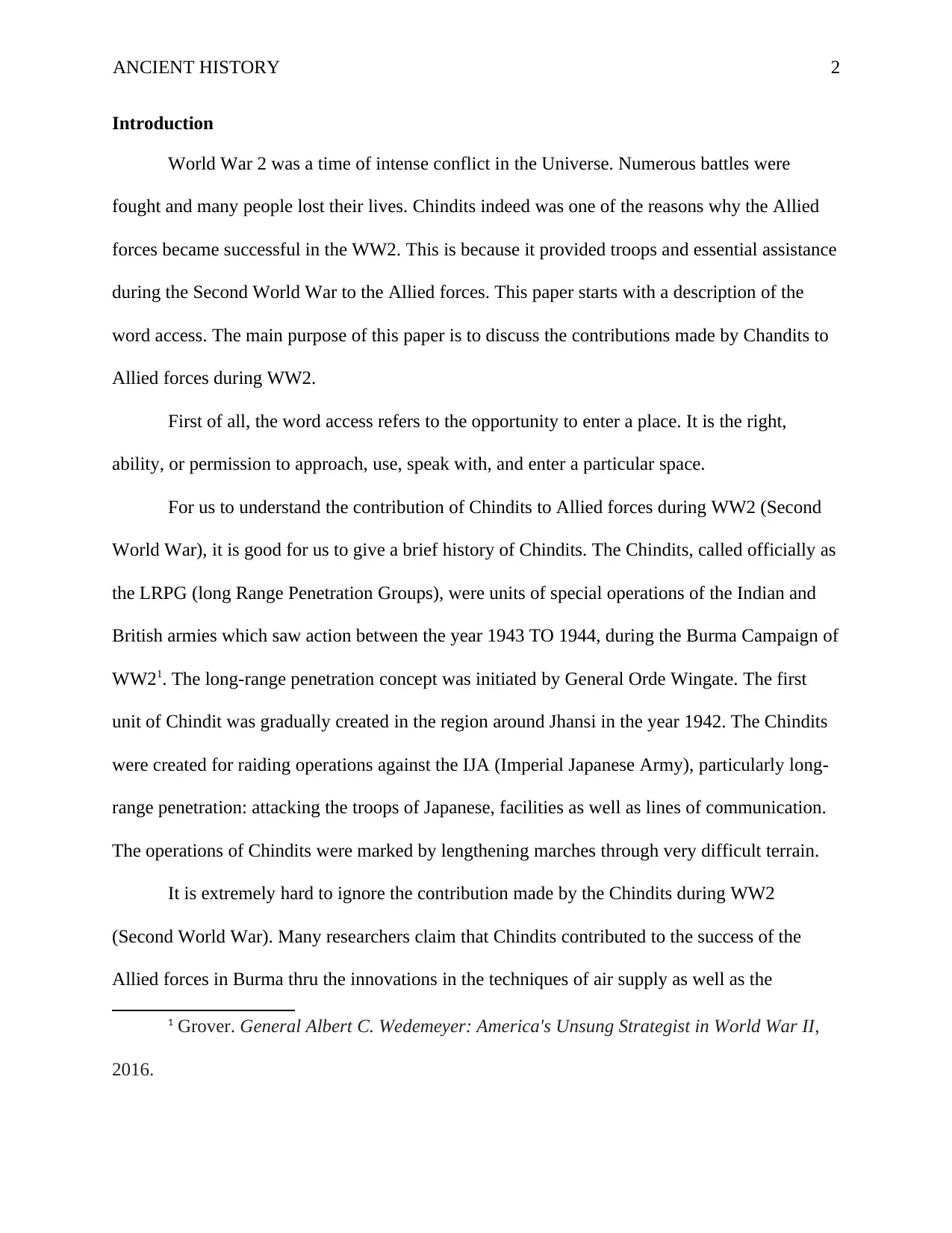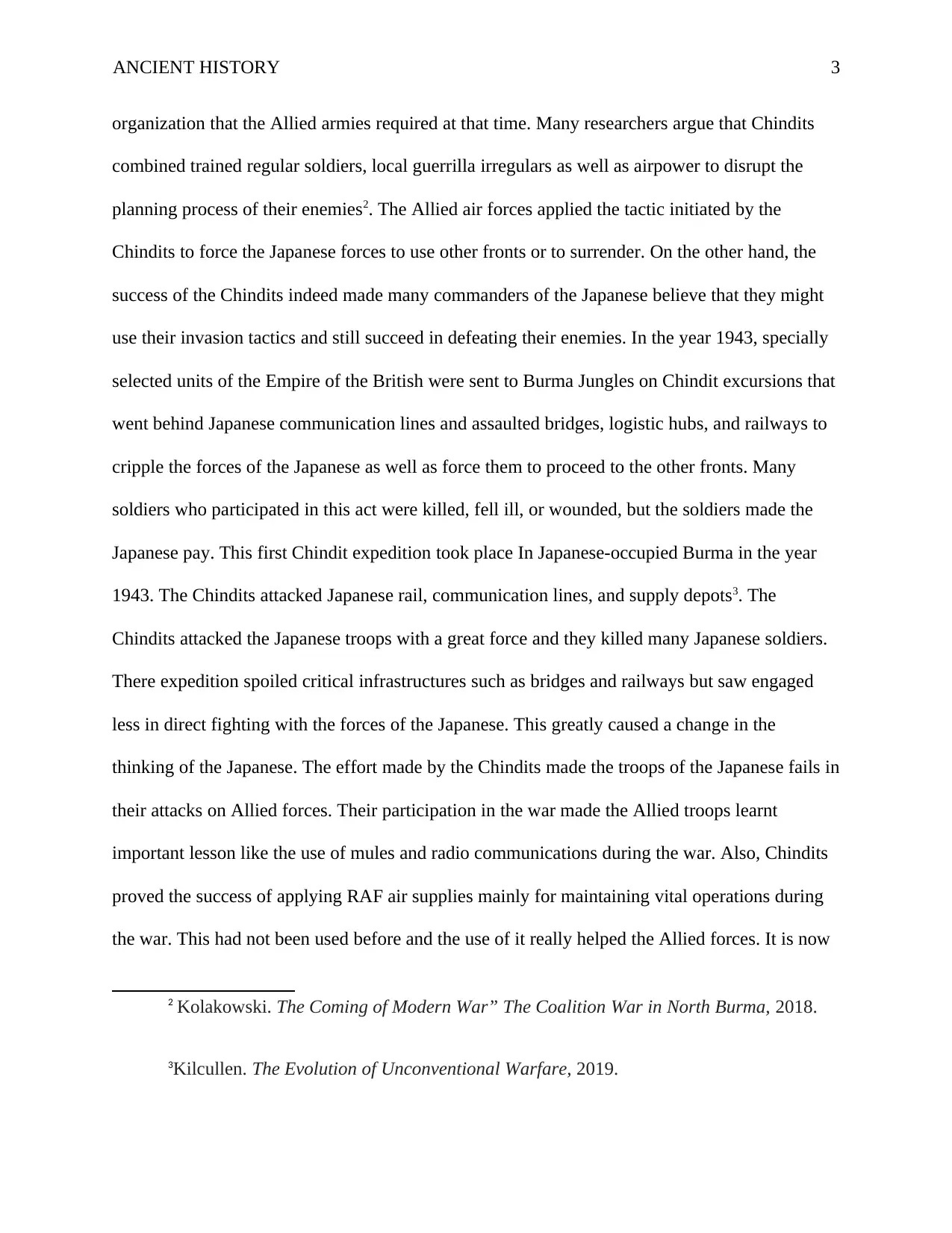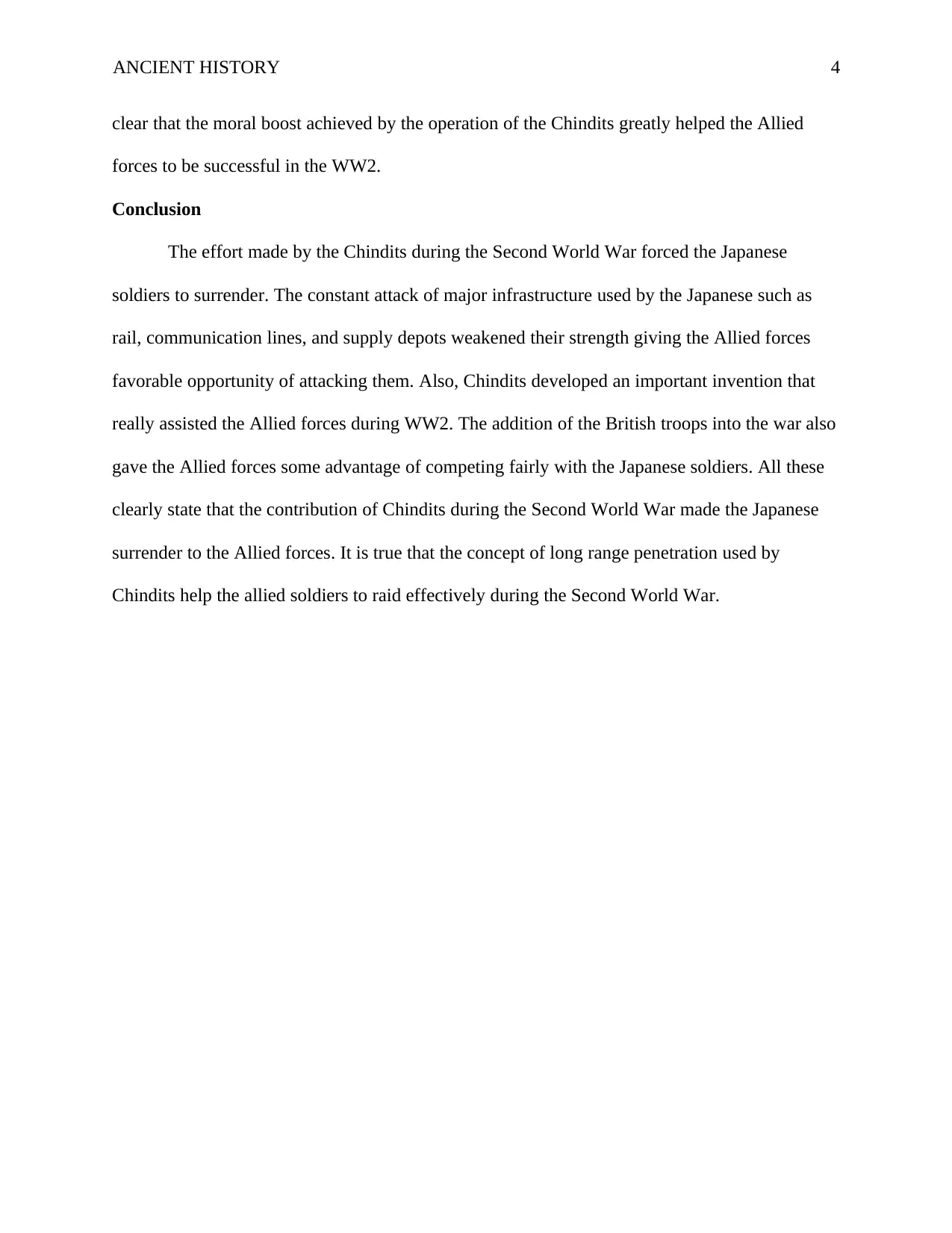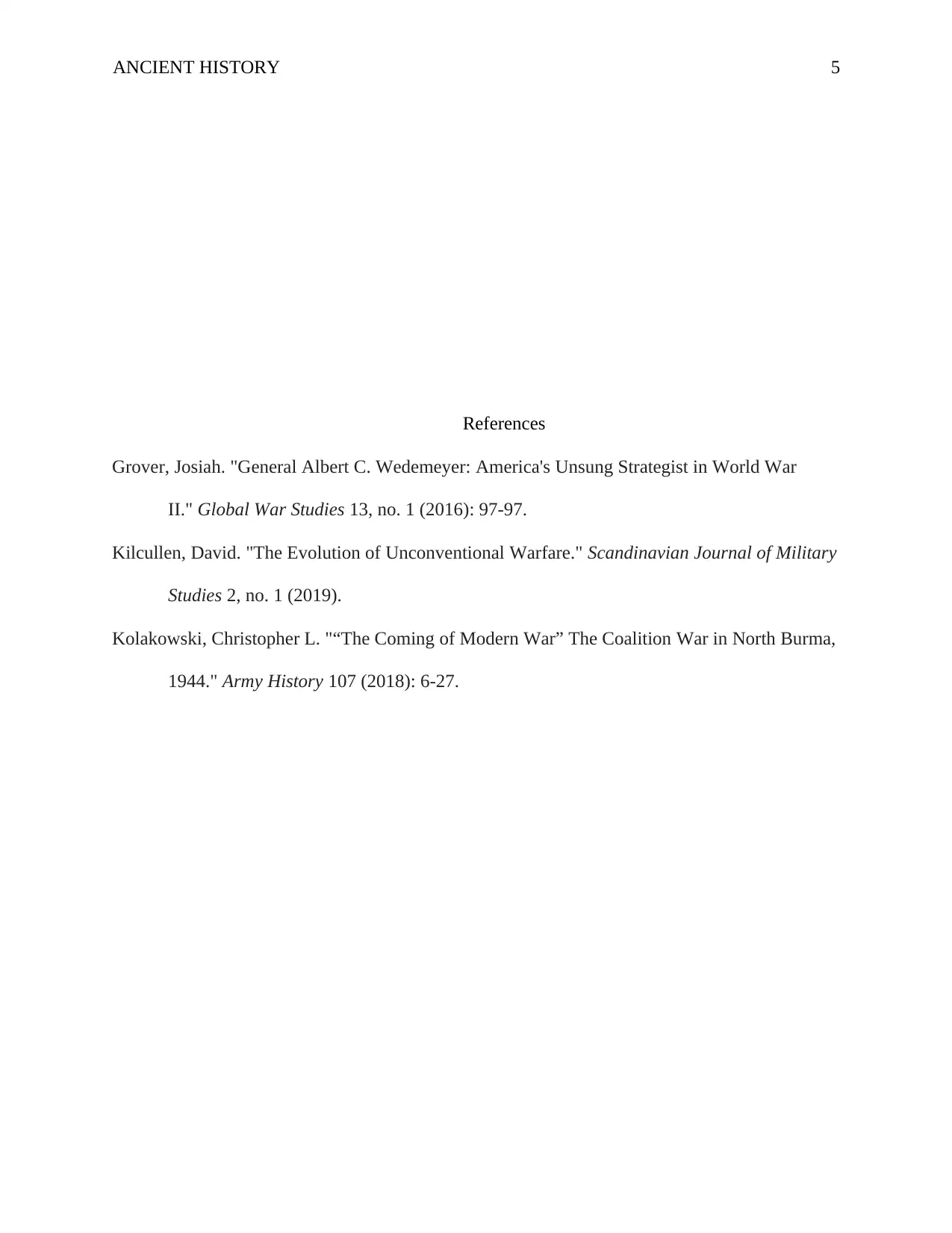The Chindits' Contributions to Allied Success in WW2
VerifiedAdded on 2022/08/22
|5
|935
|16
Essay
AI Summary
This essay delves into the contributions of the Chindits, officially known as Long Range Penetration Groups (LRPG), to the Allied forces during World War 2, specifically in the Burma Campaign. It begins by defining 'access' and then provides a historical overview of the Chindits, detailing their formation, objectives, and operational tactics initiated by General Orde Wingate. The paper emphasizes the Chindits' role in disrupting the Japanese forces through long-range penetration, air supply innovations, and guerrilla warfare. The essay highlights their impact on Japanese strategies, the lessons learned by Allied troops, and the moral boost they provided, ultimately contributing to the Allied victory. The essay also references the use of mules and radio communications during the war, showcasing how the Chindits' actions weakened the Japanese infrastructure and strengthened the Allied position.

ANCIENT HISTORY 1
Ancient History
Student
Professor
Institution
Course
Date
Ancient History
Student
Professor
Institution
Course
Date
Paraphrase This Document
Need a fresh take? Get an instant paraphrase of this document with our AI Paraphraser

ANCIENT HISTORY 2
Introduction
World War 2 was a time of intense conflict in the Universe. Numerous battles were
fought and many people lost their lives. Chindits indeed was one of the reasons why the Allied
forces became successful in the WW2. This is because it provided troops and essential assistance
during the Second World War to the Allied forces. This paper starts with a description of the
word access. The main purpose of this paper is to discuss the contributions made by Chandits to
Allied forces during WW2.
First of all, the word access refers to the opportunity to enter a place. It is the right,
ability, or permission to approach, use, speak with, and enter a particular space.
For us to understand the contribution of Chindits to Allied forces during WW2 (Second
World War), it is good for us to give a brief history of Chindits. The Chindits, called officially as
the LRPG (long Range Penetration Groups), were units of special operations of the Indian and
British armies which saw action between the year 1943 TO 1944, during the Burma Campaign of
WW21. The long-range penetration concept was initiated by General Orde Wingate. The first
unit of Chindit was gradually created in the region around Jhansi in the year 1942. The Chindits
were created for raiding operations against the IJA (Imperial Japanese Army), particularly long-
range penetration: attacking the troops of Japanese, facilities as well as lines of communication.
The operations of Chindits were marked by lengthening marches through very difficult terrain.
It is extremely hard to ignore the contribution made by the Chindits during WW2
(Second World War). Many researchers claim that Chindits contributed to the success of the
Allied forces in Burma thru the innovations in the techniques of air supply as well as the
1 Grover. General Albert C. Wedemeyer: America's Unsung Strategist in World War II,
2016.
Introduction
World War 2 was a time of intense conflict in the Universe. Numerous battles were
fought and many people lost their lives. Chindits indeed was one of the reasons why the Allied
forces became successful in the WW2. This is because it provided troops and essential assistance
during the Second World War to the Allied forces. This paper starts with a description of the
word access. The main purpose of this paper is to discuss the contributions made by Chandits to
Allied forces during WW2.
First of all, the word access refers to the opportunity to enter a place. It is the right,
ability, or permission to approach, use, speak with, and enter a particular space.
For us to understand the contribution of Chindits to Allied forces during WW2 (Second
World War), it is good for us to give a brief history of Chindits. The Chindits, called officially as
the LRPG (long Range Penetration Groups), were units of special operations of the Indian and
British armies which saw action between the year 1943 TO 1944, during the Burma Campaign of
WW21. The long-range penetration concept was initiated by General Orde Wingate. The first
unit of Chindit was gradually created in the region around Jhansi in the year 1942. The Chindits
were created for raiding operations against the IJA (Imperial Japanese Army), particularly long-
range penetration: attacking the troops of Japanese, facilities as well as lines of communication.
The operations of Chindits were marked by lengthening marches through very difficult terrain.
It is extremely hard to ignore the contribution made by the Chindits during WW2
(Second World War). Many researchers claim that Chindits contributed to the success of the
Allied forces in Burma thru the innovations in the techniques of air supply as well as the
1 Grover. General Albert C. Wedemeyer: America's Unsung Strategist in World War II,
2016.

ANCIENT HISTORY 3
organization that the Allied armies required at that time. Many researchers argue that Chindits
combined trained regular soldiers, local guerrilla irregulars as well as airpower to disrupt the
planning process of their enemies2. The Allied air forces applied the tactic initiated by the
Chindits to force the Japanese forces to use other fronts or to surrender. On the other hand, the
success of the Chindits indeed made many commanders of the Japanese believe that they might
use their invasion tactics and still succeed in defeating their enemies. In the year 1943, specially
selected units of the Empire of the British were sent to Burma Jungles on Chindit excursions that
went behind Japanese communication lines and assaulted bridges, logistic hubs, and railways to
cripple the forces of the Japanese as well as force them to proceed to the other fronts. Many
soldiers who participated in this act were killed, fell ill, or wounded, but the soldiers made the
Japanese pay. This first Chindit expedition took place In Japanese-occupied Burma in the year
1943. The Chindits attacked Japanese rail, communication lines, and supply depots3. The
Chindits attacked the Japanese troops with a great force and they killed many Japanese soldiers.
There expedition spoiled critical infrastructures such as bridges and railways but saw engaged
less in direct fighting with the forces of the Japanese. This greatly caused a change in the
thinking of the Japanese. The effort made by the Chindits made the troops of the Japanese fails in
their attacks on Allied forces. Their participation in the war made the Allied troops learnt
important lesson like the use of mules and radio communications during the war. Also, Chindits
proved the success of applying RAF air supplies mainly for maintaining vital operations during
the war. This had not been used before and the use of it really helped the Allied forces. It is now
2 Kolakowski. The Coming of Modern War” The Coalition War in North Burma, 2018.
3Kilcullen. The Evolution of Unconventional Warfare, 2019.
organization that the Allied armies required at that time. Many researchers argue that Chindits
combined trained regular soldiers, local guerrilla irregulars as well as airpower to disrupt the
planning process of their enemies2. The Allied air forces applied the tactic initiated by the
Chindits to force the Japanese forces to use other fronts or to surrender. On the other hand, the
success of the Chindits indeed made many commanders of the Japanese believe that they might
use their invasion tactics and still succeed in defeating their enemies. In the year 1943, specially
selected units of the Empire of the British were sent to Burma Jungles on Chindit excursions that
went behind Japanese communication lines and assaulted bridges, logistic hubs, and railways to
cripple the forces of the Japanese as well as force them to proceed to the other fronts. Many
soldiers who participated in this act were killed, fell ill, or wounded, but the soldiers made the
Japanese pay. This first Chindit expedition took place In Japanese-occupied Burma in the year
1943. The Chindits attacked Japanese rail, communication lines, and supply depots3. The
Chindits attacked the Japanese troops with a great force and they killed many Japanese soldiers.
There expedition spoiled critical infrastructures such as bridges and railways but saw engaged
less in direct fighting with the forces of the Japanese. This greatly caused a change in the
thinking of the Japanese. The effort made by the Chindits made the troops of the Japanese fails in
their attacks on Allied forces. Their participation in the war made the Allied troops learnt
important lesson like the use of mules and radio communications during the war. Also, Chindits
proved the success of applying RAF air supplies mainly for maintaining vital operations during
the war. This had not been used before and the use of it really helped the Allied forces. It is now
2 Kolakowski. The Coming of Modern War” The Coalition War in North Burma, 2018.
3Kilcullen. The Evolution of Unconventional Warfare, 2019.
⊘ This is a preview!⊘
Do you want full access?
Subscribe today to unlock all pages.

Trusted by 1+ million students worldwide

ANCIENT HISTORY 4
clear that the moral boost achieved by the operation of the Chindits greatly helped the Allied
forces to be successful in the WW2.
Conclusion
The effort made by the Chindits during the Second World War forced the Japanese
soldiers to surrender. The constant attack of major infrastructure used by the Japanese such as
rail, communication lines, and supply depots weakened their strength giving the Allied forces
favorable opportunity of attacking them. Also, Chindits developed an important invention that
really assisted the Allied forces during WW2. The addition of the British troops into the war also
gave the Allied forces some advantage of competing fairly with the Japanese soldiers. All these
clearly state that the contribution of Chindits during the Second World War made the Japanese
surrender to the Allied forces. It is true that the concept of long range penetration used by
Chindits help the allied soldiers to raid effectively during the Second World War.
clear that the moral boost achieved by the operation of the Chindits greatly helped the Allied
forces to be successful in the WW2.
Conclusion
The effort made by the Chindits during the Second World War forced the Japanese
soldiers to surrender. The constant attack of major infrastructure used by the Japanese such as
rail, communication lines, and supply depots weakened their strength giving the Allied forces
favorable opportunity of attacking them. Also, Chindits developed an important invention that
really assisted the Allied forces during WW2. The addition of the British troops into the war also
gave the Allied forces some advantage of competing fairly with the Japanese soldiers. All these
clearly state that the contribution of Chindits during the Second World War made the Japanese
surrender to the Allied forces. It is true that the concept of long range penetration used by
Chindits help the allied soldiers to raid effectively during the Second World War.
Paraphrase This Document
Need a fresh take? Get an instant paraphrase of this document with our AI Paraphraser

ANCIENT HISTORY 5
References
Grover, Josiah. "General Albert C. Wedemeyer: America's Unsung Strategist in World War
II." Global War Studies 13, no. 1 (2016): 97-97.
Kilcullen, David. "The Evolution of Unconventional Warfare." Scandinavian Journal of Military
Studies 2, no. 1 (2019).
Kolakowski, Christopher L. "“The Coming of Modern War” The Coalition War in North Burma,
1944." Army History 107 (2018): 6-27.
References
Grover, Josiah. "General Albert C. Wedemeyer: America's Unsung Strategist in World War
II." Global War Studies 13, no. 1 (2016): 97-97.
Kilcullen, David. "The Evolution of Unconventional Warfare." Scandinavian Journal of Military
Studies 2, no. 1 (2019).
Kolakowski, Christopher L. "“The Coming of Modern War” The Coalition War in North Burma,
1944." Army History 107 (2018): 6-27.
1 out of 5
Related Documents
Your All-in-One AI-Powered Toolkit for Academic Success.
+13062052269
info@desklib.com
Available 24*7 on WhatsApp / Email
![[object Object]](/_next/static/media/star-bottom.7253800d.svg)
Unlock your academic potential
Copyright © 2020–2025 A2Z Services. All Rights Reserved. Developed and managed by ZUCOL.





